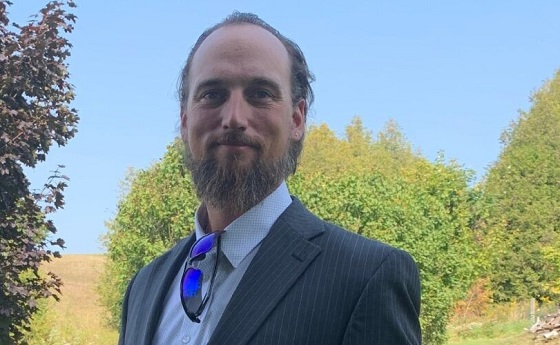COVID-19
Undue Censorship Still Skews COVID Treatments

From the Frontier Centre for Public Policy
By Lee Harding
The censorship and institutional capture evident in the pandemic should be an ongoing concern for policy-makers, scientists, and the medical field. Someone who encountered this first-hand was clinical trials researcher Sabine Hazan, who testified to the National Citizens Inquiry on COVID-19.
Hazan, the CEO and principal investigator at Venture Clinical Trials is also the founder and CEO of Progena Biome, a genetic sequencing lab. Starting in 2020, she subjected stool samples of COVID-19 patients’ to next-generation sequencing (NGS) of the entire genome of the virus.
It wasn’t long before the tests, which were $3,000 each, showed the virus mutating into four different spike proteins. Patients had anywhere from one to all of them.
“‘How is the vaccine going to work if the spike protein itself is mutating into multiple combinations?’” she asked herself.
“Vaccinating against viruses is not a really a good idea because unfortunately, viruses mutate more than bacteria.”
Hazan was curious about three cases where the virus had completely disappeared by day five. Two of these patients said they had been taking hydroxychloroquine and azithromycin.
On April 2, 2020, Hazan submitted a protocol to treat COVID-19 consisting of hydroxychloroquine, azithromycin, vitamins C, D, and zinc. The Food and Drug Administration (FDA) approved a request to do clinical trials within 24 hours, yet Facebook, Twitter, and Instagram blocked her advertisements for patients.
The few patients Hazan could recruit faced another hurdle as medical authorities warned pharmacists not to prescribe hydroxychloroquine and azithromycin together because of cardiac problems. Her monitoring of patients never revealed such problems.
“These drugs have been given to millions of people with arthritis, and all of a sudden, they’re bad?” she asked.
In the first 16 of 17 patients, the virus disappeared from stool samples between 5 to 8 days after being on the regimen. Hazan applied for a patent for her protocol in July 2020 and received it in December 2020. An unnamed party or parties offered her $10 million, then $40 million for her patent, but refused the money to continue her research.
Hazan found newborns have a lot of bifidobacteria and the elderly have little to none. Her research suggests that boosting a person’s microbiomes can address c difficile, anxiety, Lyme Disease, Crohn’s, psoriasis, Alzheimer’s, and cancer, while its deficiencies may be related to autism.
She had concerns from the vaccines from the start, but authorities kept doctors in California like her from warning patients about possible side effects.
“What I realized doing clinical trials is I couldn’t always trust pharmaceutical companies,” she said.
“When people are coming at me with a new medication that has been tested on animals for one week, I start freaking out.”
Some of her studies waited 6 to 8 months to get published, while 52 have not yet found a journal willing to print them.
“I’m trying to publish the data on the messenger RNA [of COVID vaccines] affecting the microbiome, which won a Research Award at the American College of Gastro[enterology], and nobody’s interested in publishing that.”
This study of more than 150 vaccine-injured patients found the entire phylum of bifidobacteria had been “wiped” out.
Frontiers in Microbiology published her most popular paper, Microbiome-Based Hypothesis on Ivermectin’s Mechanism in COVID-19: Ivermectin Feeds Bifidobacteria to Boost Immunity in July of 2022. The paper received 47,000 views before a complaint led to its retraction in May of 2023.
Twitter deemed her hypothesis as “misinformation” long before the retraction and blocked her account. Some of Hazan’s own patients who worked for Twitter helped get her account reinstated but could not keep her from a ‘misinformation’ label on her posts.
“I was doing the clinical trials. I was treating the patients, I was analyzing the stools. I was working with the FDA. Who’s giving misinformation? I’m publishing. You’re telling me I’m misinforming people?” she recalled thinking.
Hazan expressed concern that a “movement” to retract papers has yanked more than 14,000 of them and artificial intelligence will ignore them.
“What’s interesting about these papers is they all go against the narrative that is meant to sell you something. So that’s dangerous…if you’re trying to push a drug, or biologic, and now you’re removing everything else,” she said.
Such one-sided medical dogma is wrong, she insisted.
“That’s not science. That’s propaganda. That’s what we saw this pandemic,” said Hazan.
“Now I’m blacklisted from a lot of pharmaceutical companies…It actually killed my business of doing clinical trials.”
The fact that mRNA vaccines are still being pushed concerns the Moroccan-born doctor.
“You talk to scientists who do animal studies on the mRNA, they will tell you that the rats are eating their arms. So that’s all I need to hear,” she said.
“The technology may be promising, maybe, but it’s not there yet. It’s still very much experimental.”
Let’s hope more scientists, doctors, and journal publishers will find the integrity and courage of Hazan. Citizens have reason for concern that regulators have pushed risky mRNA vaccines while undermining the legitimacy of other promising options. When will honest science prevail?
Lee Harding is a Research Fellow at the Frontier Centre for Public Policy.
COVID-19
Judge denies Canadian gov’t request to take away Freedom Convoy leader’s truck

From LifeSiteNews
A judge ruled that the Ontario Court of Justice is already ‘satisfied’ with Chris Barber’s sentence and taking away his very livelihood would be ‘disproportionate.’
A Canadian judge has dismissed a demand from Canadian government lawyers to seize Freedom Convoy leader Chris Barber’s “Big Red” semi-truck.
On Friday, Ontario Court of Justice Judge Heather Perkins-McVey denied the Crown’s application seeking to forfeit Barber’s truck.
She ruled that the court is already “satisfied” with Barber’s sentence and taking away his very livelihood would be “disproportionate.”
“This truck is my livelihood,” said Barber in a press release sent to LifeSiteNews.
“Trying to permanently seize it for peacefully protesting was wrong, and I’m relieved the court refused to allow that to happen,” he added.
Criminal defense lawyer Marwa Racha Younes was welcoming of the ruling as well, stating, “We find it was the right decision in the circumstances and are happy with the outcome.”
John Carpay, president of the Justice Centre for Constitutional Freedoms (JCCF), said the decision is “good news for all Canadians who cherish their Charter freedom to assemble peacefully.”
READ: Freedom Convoy protester appeals after judge dismissed challenge to frozen bank accounts
“Asset forfeiture is an extraordinary power, and it must not be used to punish Canadians for participating in peaceful protest,” he added in the press release.
As reported recently by LifeSiteNews, the Canadian government claimed that Barber’s truck is an “offence-related property” relating to his involvement in the 2022 protests against Canada’s COVID mandates.
At this time, the court ruling ends any forfeiture proceedings for the time being, however Barber will continue to try and appeal his criminal conviction and house arrest sentence.
Barber’s truck, a 2004 Kenworth long-haul he uses for business, was a focal point in the 2022 protests. He drove it to Ottawa, where it was parked for an extended period of time, but he complied when officials asked him to move it.
On October 7, 2025, after a long trial, Ontario Court Justice Perkins-McVey sentenced Barber and Tamara Lich, the other Freedom Convoy leader, to 18 months’ house arrest. They had been declared guilty of mischief for their roles as leaders of the 2022 protest against COVID mandates, and as social media influencers.
Lich and Barber have filed appeals of their own against their house arrest sentences, arguing that the trial judge did not correctly apply the law on their mischief charges.
Government lawyers for the Crown have filed an appeal of the acquittals of Lich and Barber on intimidation charges.
The pair’s convictions came after a nearly two-year trial despite the nonviolent nature of the popular movement.
COVID-19
Freedom Convoy protester appeals after judge dismissed challenge to frozen bank accounts

From LifeSiteNews
Protestor Evan Blackman’s legal team argues Trudeau’s Emergencies Act-based bank account freezes were punitive state action tied directly to protest participation.
A Freedom Convoy protester whose bank accounts were frozen by the Canadian government says a judge erred after his ruling did not consider the fact that the funds were frozen under the Emergencies Act, as grounds for a stay of proceedings.
In a press release sent out earlier this week, the Justice Centre for Constitutional Freedoms (JCCF) said that Freedom Convoy protestor Evan Blackman will challenge a court ruling in his criminal case via an appeal with the Ontario Superior Court of Justice.
“This case raises serious questions about how peaceful protest is treated in Canada and about the lasting consequences of the federal government’s unlawful use of the Emergencies Act,” noted constitutional lawyer Chris Fleury. “The freezing of protestors’ bank accounts was part of a coordinated effort to suppress dissent, and courts ought to be willing to scrutinize that conduct.”
Blackman was arrested on February 18, 2022, during the police crackdown on Freedom Convoy protests against COVID restrictions, which was authorized by the Emergencies Act (EA). The EA was put in place by former Prime Minister Justin Trudeau’s Liberal government, which claimed the protests were violent, despite no evidence that this was the case.
Blackman’s three bank accounts with TD Bank were frozen due to his participation in the Freedom Convoy, following a directive ordered by Trudeau.
As reported by LifeSiteNews, in November of this year, Blackman was convicted at his retrial even though he had been acquitted at his original trial. In 2023, Blackman’s “mischief” and “obstructing police” charges were dismissed by a judge due to lack of evidence and the “poor memory of a cop regarding key details of the alleged criminal offences.”
His retrial resulted in Blackman getting a conditional discharge along with 12 months’ probation and 122 hours of community service, along with a $200 victim fine surcharge.
After this, Blackman’s application for a stay of proceedings was dismissed by the court. He had hoped to have his stay of proceedings, under section 24(1) of the Charter of Rights and Freedoms, allowed. However, the judge ruled that the freezing of his bank accounts was legally not related to his arrest, and because of this, the stay of proceedings lacked standing.
The JCCF disagreed with this ruling, noting, it “stands in contrast to a Federal Court decision finding that the government’s invocation of the Emergencies Act was unreasonable and violated Canadians’ Charter rights, including those targeted by the financial measures used against Freedom Convoy protestors.”
As of press time, a hearing date has not been scheduled.
In 2024, Federal Court Justice Richard Mosley ruled that Trudeau was “not justified” in invoking the Emergencies Act.
In early 2022, the Freedom Convoy saw thousands of Canadians from coast to coast come to Ottawa to demand an end to COVID mandates in all forms. Despite the peaceful nature of the protest, Trudeau’s federal government enacted the EA in mid-February.
After the protesters were cleared out, which was achieved through the freezing of bank accounts of those involved without a court order as well as the physical removal and arrest of demonstrators, Trudeau revoked the EA on February 23, 2022.
-

 International11 hours ago
International11 hours agoGeorgia county admits illegally certifying 315k ballots in 2020 presidential election
-

 Business2 days ago
Business2 days agoICYMI: Largest fraud in US history? Independent Journalist visits numerous daycare centres with no children, revealing massive scam
-

 Alberta1 day ago
Alberta1 day agoAlberta project would be “the biggest carbon capture and storage project in the world”
-

 Energy1 day ago
Energy1 day agoCanada’s debate on energy levelled up in 2025
-

 Haultain Research13 hours ago
Haultain Research13 hours agoSweden Fixed What Canada Won’t Even Name
-

 Business12 hours ago
Business12 hours agoWhat Do Loyalty Rewards Programs Cost Us?
-

 Business1 day ago
Business1 day agoSocialism vs. Capitalism
-

 Energy1 day ago
Energy1 day agoNew Poll Shows Ontarians See Oil & Gas as Key to Jobs, Economy, and Trade




